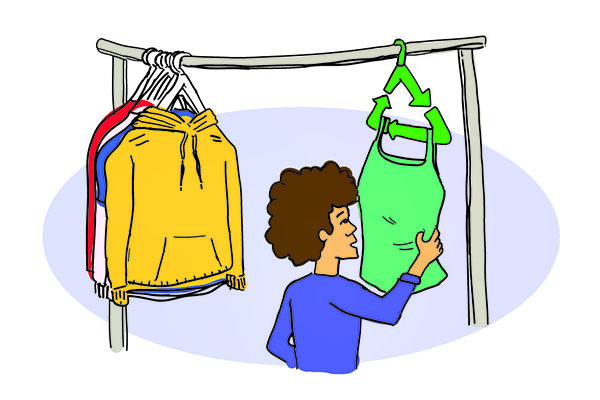UT students, staff discuss ways to participate in the sustainable fashion industry
September 11, 2021
Standing in a warehouse littered with clothes, fabric mountains reaching towards the ceiling, Karla Villegas started to dig through layers upon layers. Unwanted items turned into hidden treasures in her hands. After her first visit to a rag house, which is a wholesale vintage recycling plant, in McAllen, Texas, Villegas began consciously shopping sustainably.
“It was shocking to see (how rag houses) work,” said Villegas, a radio-television-film sophomore. “Those are also prominent with people who really need to go there and it’s the only option (where) they can buy clothes. It was really eye-opening to see, ‘Wow, people are throwing away all these clothes. That’s insane.’”
Fast fashion stores such as SHEIN, Zara and H&M draw consumers in with their affordable prices and trendy styles. However, according to the U.S. Environmental Protection Agency, in 2018, 66% of generated textiles ended up in landfills. To support fashion sustainability, students such as Villegas gravitate toward inexpensive and unique pieces at thrift and vintage stores.
“It’s more satisfying for you to go out and pick something that, in a way, might be meant for you, rather than to get something mass produced on SHEIN,” Villegas said. “Not only is it good for the environment, but it also makes you look cool.”
Vertica Bhardwaj, textiles and apparel associate professor, said building a sustainable fashion industry requires change on both the individual and societal level. She suggested college students start taking steps toward sustainability by learning more about the fashion industry through social media, following campaigns like Greenpeace and Remake, and supporting ethical brands such as Patagonia and The North Face.
“What calls for a change is voluntary consumption, where people start to actually think and ask themselves what their core values are,” Bhardwai said.
Apart from buying and selling used clothes, advertising sophomore Kristy Thai practices sustainability through her business, Clutter. Giving a second life to old jewelry by repurposing used beads, she transforms them into trendy, one-of-a-kind necklaces.
When Thai launched Clutter in January 2021, she made a commitment to using sustainable practices, such as using eco-friendly packaging, recyclable mailers and biodegradable labels. Despite her efforts, however, challenges still arise.
“It’s very difficult to be a sustainable brand when the industry itself thrives off of going from production to consumption to disposal,” Thai said. “We’re eco-conscious, and we recognize how hard it is to be labeled as sustainable. It’s an ongoing effort.”
Although Mercari, an online marketplace, remains Thai’s main bead buying source, she also scavenges through thrift shops and her friend’s and family’s unwanted jewelry. This way, she remains true to her philosophy and provides each customer with an individual experience.
“No one piece is the same,” Thai said. “It reflects how thrifting is. When you buy something at the thrift store, it’s really rare that someone else has the same thing. It adds an element of individuality and makes you unique.”



